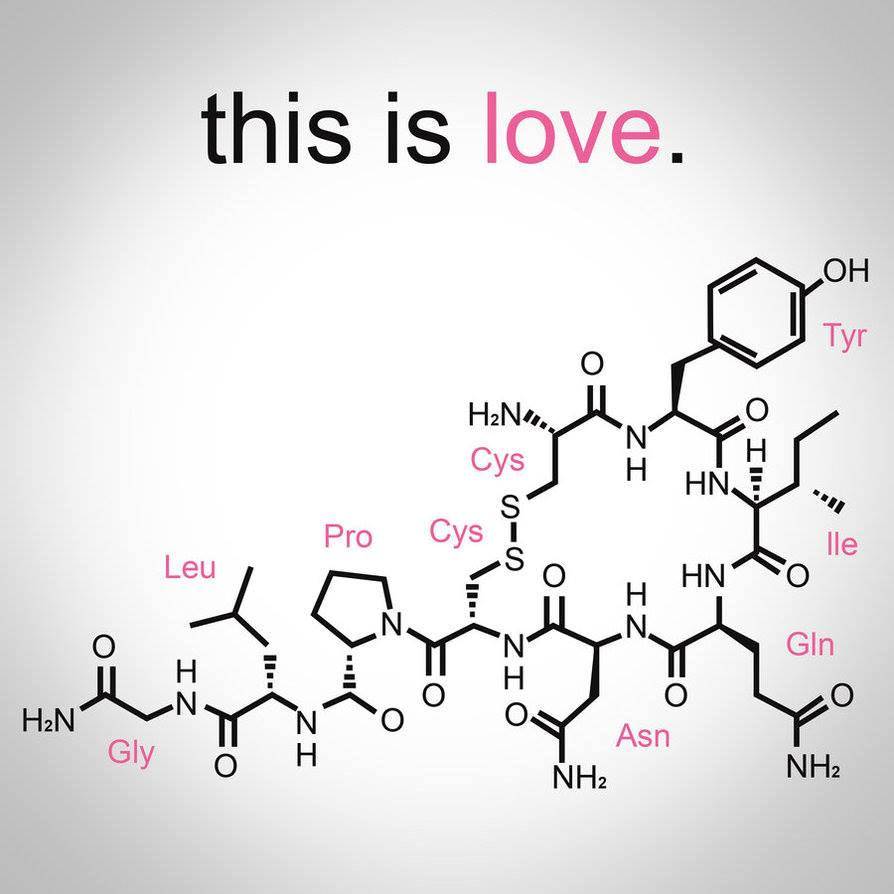First published: February 18, 2020
In honor of Valentine’s Day, we introduce to you the “Celebritide” Oxytocin (structure shown above), often called the Love Hormone. Oxytocin is a naturally occurring peptide hormone and neuropeptide produced in the hypothalamus and released by the posterior pituitary gland. Physiologically, it is released during child-birth and helps stimulate uterine contractions during labor assisting in delivering a child. Post-childbirth it plays a major role in social bonding of the mother to child and also stimulation of lactation in the mother. It is this “bonding” activity that gives rise to the Love hormone connotation.
It was in fact the first synthetic peptide produced for human use. Oxytocin is a relative small 9 residue peptide containing a single disulfide bond. It was originally isolated in 1906 by Dale (1). It was successfully sequenced (2) and subsequently synthesized by du Vigneaud back in the early 1950’s (3-5). Victor du Vigneaud was awarded the Nobel Prize in 1955 for his work on oxytocin (6). Oxytocin is a conserved peptide found across all vertebrate species.
Synthetic oxytocin, also called Pitocin or Syntocinon, is now regularly prescribed during child birth to induce as well as augment labor. The Journal of the American Medical Association estimated in 1998 that 16% of labors are induced in the U.S., and an additional 16% of labors that start spontaneously are augmented with inducing drugs. Oxytocin is also administered just after birth to prevent postpartum hemorrhage if the uterus does not continue to contract and stop bleeding. Less commonly, a nasal spray formulation of oxytocin is sometimes given to mothers who have trouble with milk let-down in the first few days of nursing.
Initially, researchers saw oxytocin primarily as a pregnancy hormone because of its roles in childbirth and nursing. More recently, scientists are revealing many different effects of oxytocin in both men and women. Oxytocin has more pleiotropic effects than scientists had realized. Researchers began to suspect a broader role for oxytocin when they saw that the same receptor that reaches such high concentrations in the laboring uterus is found in other tissues in both men and women, including the brain, heart, and reproductive tract. Some researchers suspect, in addition, that there are one or more as-yet-unidentified oxytocin receptors. Oxytocin plays a large, and largely unexplored, role in the brain. Oxytocin is not only a hormone that circulates in the bloodstream, it is also a neurotransmitter that travels in nerve cells in the brain and elsewhere. The cells that make oxytocin in the hypothalamus and send it to the pituitary gland as well as to oxytocin to different regions of the brain. Moreover, cells of the hypothalamus are not the only cells that make oxytocin. The ovaries, testicles, heart, and blood vessel walls have all been shown to produce their own oxytocin.
References
- Dale HH (May 1906). “On some physiological actions of ergot”. The Journal of Physiology. 34 (3): 163–206. doi:10.1113/jphysiol.1906.sp001148. PMC 1465771. PMID 16992821.
- Du Vigneaud V, Ressler C, Trippett S (December 1953). “The sequence of amino acids in oxytocin, with a proposal for the structure of oxytocin”. The Journal of Biological Chemistry. 205 (2): 949–57. PMID 13129273.
- Du Vigneaud V, Ressler C, Swan JM, Roberts CW, Katsoyannis PG, Gordon S (1953). “The synthesis of an octapeptide amide with the hormonal activity of oxytocin”. J. Am. Chem. Soc. 75 (19): 4879–80. doi:10.1021/ja01115a553.
- Du Vigneaud V, Ressler C, Swan JM, Roberts CW, Katsoyannis PG (June 1954). “The synthesis of oxytocin”. J. Am. Chem. Soc. 76 (12): 3115–3121. doi:10.1021/ja01641a004.
- Du Vigneaud V, Ressler C, Swan JM, Roberts CW, Katsoyannis PG (1954). “The Synthesis of Oxytocin1”. Journal of the American Chemical Society. 76 (12): 3115–21. doi:10.1021/ja01641a004.
- The Nobel Prize in Chemistry 1955″. Nobelprize.org. Nobel Media AB.

 中文
中文